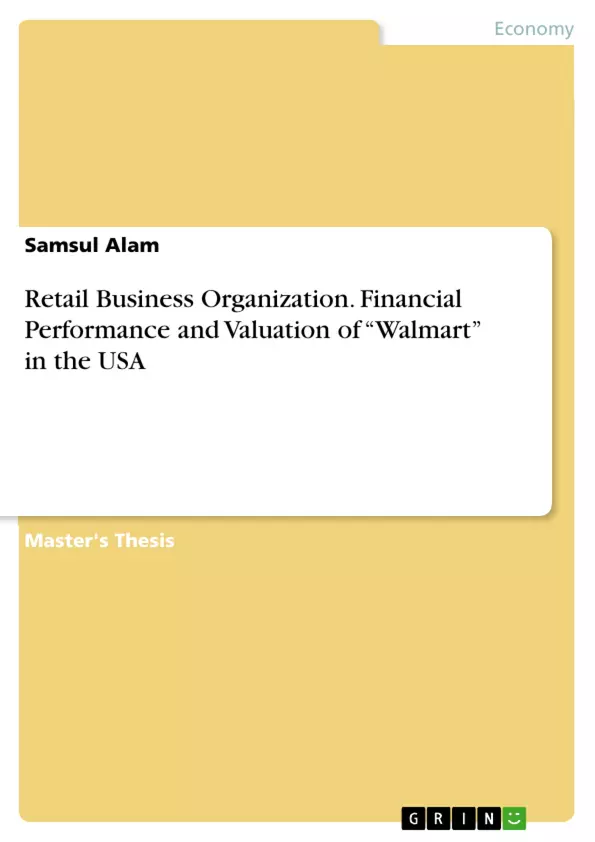The main objective of this study is to present the ins and outs of retail business in the world especially in the United States of America (USA) and present Walmart’s financial performance making the important valuation of the company as well as showing competitive circumstances which is essential in the eye of the financial market analyst, investors and customers.
The finding of this detailed descriptive study with sufficient financial analysis and comparative variables is that Walmart is the lucrative choice for the past, present and future investors with the estimation of terminal value at the end of the fiscal year 2026 estimated US $580 billion and the fundamental value of US $735 billion. The assumption is made on in-depth financial analysis with reliable data and calculation.
The result of this study shows that due to the emergence of stronger competitors and for being matured, Walmart is not performing as expected by investors but its gigantic market size and capital will make it capable of doing business profitably over a longer period of time. The ultimate decision given in this study for the investors is to buy. This study gives the future researcher a basis on doing further theoretical and empirical research basis on this industry leading company.
Table of Contents
- ABSTRACT
- SECTION-A: INTRODUCTION
- SECTION-B: THEORETICAL FRAMEWORK-
- OVERVIEW OF RETAILING
- RETAILING IN THE WORLD VS. USA.
- WALMART ANALYSIS: CRITICS AND PRAISE
- SECTION-C: PRESENTATION OF WALMART.
- BRIEF HISTORY
- CORPORATE PROFILE
- BUSINESS DYNAMICS AND FINANCIAL TRENDS
- SECTION-D: WALMART MARKET ANALYSIS.
- PERFORMANCE METRICS.
- COMPETITIVE CIRCUMSTANCES-
- MAJOR COMPETITORS PROFILE
- Competitive Advantage--
- SWOT ANALYSIS OF WALMART
- MICRO LEVEL ANALYSIS (PORTER'S FIVE FORCES MODEL)
- Threat of substitute products and services-
- Threat of new entrants---------\nCompetitive rivalry within the industry
- Bargaining power of customers
- Bargaining power of suppliers
- MARKET RISK
- Currency Risk-
- Strategy and Competitive Forces
- SECTION-E: HISTORICAL FINANCIAL DATA AND FREE CASH FLOW FORECASTS
- FINANCIALS
- KEY RATIOS
- FREE CASH FLOW FORECASTS
- PERSISTENCE AND SUSTAINABILITY OF HISTORICAL FINANCIAL DATA-
- SECTION-F: WALMART VALUATION AND COMPARISON
- CONCEPTUAL APPROACH TO VALUATION
- PERPETUAL GROWTH RATE
- WEIGHTED AVERAGE COST OF CAPITAL (WACC).
- Calculating Cost of Equity, Ke
- Calculating Cost of Debt, Ka
- Calculating Weighted Average Cost of Capital (WACC).
- TERMINAL VALUE
- FUNDAMENTAL VALUE
- MARKET VALUE (MV).
- Market Capitalization
- Enterprise Value (EV).
- COMPARISON
- SECTION-G: ANALYSIS, RECOMMENDATION AND CONCLUSION-
- FUNDAMENTAL ANALYSIS AND RECOMMENDATION
Objectives and Key Themes
This study aims to provide an in-depth analysis of the retail business in the world, with a specific focus on the United States of America (USA). It analyzes the financial performance of Walmart Stores, Inc., the world's largest retail company, and presents a valuation of the company. The study also examines the competitive circumstances facing Walmart, which is crucial for financial market analysts, investors, and customers.
- Retail Business in the World, particularly in the USA
- Financial Performance of Walmart Stores, Inc.
- Valuation of Walmart
- Competitive Circumstances in the Retail Industry
- Future Prospects and Investment Recommendations for Walmart
Chapter Summaries
- ABSTRACT: Provides a brief overview of the study, highlighting its objectives, key findings, and conclusions. It emphasizes the importance of Walmart's financial analysis and valuation in understanding its competitive position and investment potential.
- SECTION-A: INTRODUCTION: Introduces the topic of retail business and sets the context for the study of Walmart. It discusses the importance of the retail sector and its relevance to the global economy.
- SECTION-B: THEORETICAL FRAMEWORK: Presents a theoretical framework for understanding the retail industry. It includes a discussion of the evolution of retailing, the different types of retail formats, and the key factors that influence retail success.
- SECTION-C: PRESENTATION OF WALMART: Provides a detailed overview of Walmart, including its history, corporate structure, business model, and financial performance.
- SECTION-D: WALMART MARKET ANALYSIS: Analyzes the competitive landscape in which Walmart operates. It includes a discussion of major competitors, industry trends, and Porter's Five Forces analysis.
- SECTION-E: HISTORICAL FINANCIAL DATA AND FREE CASH FLOW FORECASTS: Presents a comprehensive analysis of Walmart's financial performance. It includes key ratios, free cash flow forecasts, and an assessment of the persistence and sustainability of Walmart's historical financial data.
- SECTION-F: WALMART VALUATION AND COMPARISON: Provides a detailed valuation of Walmart using a variety of methods. It includes a comparison of the company's intrinsic value with its market value and a discussion of the implications for investors.
Keywords
This study focuses on Walmart, financial analysis, the retail industry, market analysis, and valuation. It examines the performance of Walmart in the context of its competitive environment, providing insights into the company's financial health, future prospects, and investment potential. Key concepts include free cash flow forecasting, cost of capital, terminal value, and investment recommendations based on a thorough assessment of Walmart's financial position.
- Quote paper
- Samsul Alam (Author), 2016, Retail Business Organization. Financial Performance and Valuation of “Walmart” in the USA, Munich, GRIN Verlag, https://www.grin.com/document/916809



